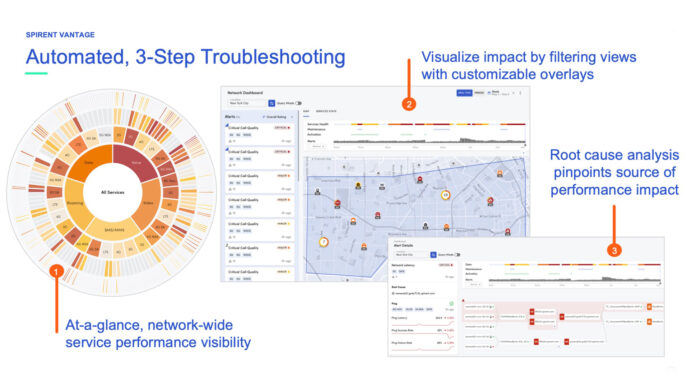Service providers have to deal with increasing complexity in their networks and services, amid what have been highly manual and ponderous service assurance deployments that almost inevitably result in visibility gaps and too much data that needs highly skilled human interpretation to resolve issues.
As Charles Thompson, VP of product management at Spirent Communications with a history of more than two decades in service assurance, put it, ”Service assurance for operators has traditionally been very burdensome. It’s been a very big deployment, [with] multi-week, multi-month services engagement to do, to get things up and running.” There’s typically a highly manual process of deploying software or hardware-based test agents: Figuring out where you want them, configuring them, pushing them out and often still being left with “massive visibility gaps” as new data centers and other new network elements come online or, in a software-defined networking world, as virtual machines spin up and down and routing changes in response
Spirent Communications aims to simplify and automate with the launch if a new service assurance solution, Vantage. Spirent is ”hyperfocused… on the mobile core” with the Vantage release, said Thompson, and invested in the solution with an eye toward how it expects networks to continue evolving over the next three to five years: A continuing push for 5G and the use of open, cloud-native and containerized infrastructure and multi-vendor environments, combined with massive data demand, and the need to assure new use cases, features and services that have not existed before, like Ultra-Reliable Low Latency Communication (URLLC).
This new network environment, he said, “introduces interesting promise for new capabilities that are being made available via 5G, but also brings with it the responsibility on the providers and on the consumers to be able to understand exactly what’s happening in the environment.
“We saw a lot of evolution happening in the market, and with that, Spirent decided that it was time for us to invest even more heavily in service assurance than we already have,” he continued, and focus specifically on the needs of network operators who will be operating Standalone (SA) and Non-Standalone (NSA) environments who needed “quick, easy, automated service assurance capabilities,” according to the company.
“The burden and the onus is almost always put on NOC teams to be able to interpret the results and know what to do next. That is … what service assurance has been in its history,” said Thompson. ”As we evolve … as a space, … we’re starting to take that data that we traditionally just blasted on the screen and left users to their own devices, so to speak, and we’re starting to draw more conclusions from it, and running fairly advanced ML/AI to be able to interpret the results and be able to provide next-step analysis and root-cause analysis.
“There are technologies out there on the market that can tell you that a problem is occurring. There are far, far fewer products out there —and frankly, far [fewer] skilled technicians out there — that can tell you why it’s occurring and what should be done to resolve it. That’s what we want to automate with the Vantage product.”
The testing and assurance company is emphasizing the turn-key nature of the new offering, as well as its automation and AI aspects — essentially, the company is trying to translate its experience in service assurance, as well as human expertise, into something that can be utilized by machines to solve network and service issues.
Vantage includes a pre-built library of test suites that it enables on-demand and “continuous testing straight out of the box from day one,” as Spirent describes it. Thompson says that the automation of deployment of learning- capable agents — both virtual and smartphone-based agents that can run over-the-air tests — not only improves visibility, but shortens deployment time as well as time to resolution.
“5G networks are much more complex than previous mobile technologies with the introduction of disaggregation, edge computing, cloud-native architecture, and multi-vendor environments. It’s taking predictable network and data constructs and evolving them into dynamic and flexible systems,” said Doug Roberts, GM of Spirent’s lifecycle service assurance business. “Vantage tackles this complexity so operations teams can easily understand their network and service performance at a glance, proactively identify issues, and rapidly isolate the cause of problems.”
“5G offers great potential for the telecom industry, but it comes with a steep increase in operational complexity. Mobile operators are already stretched by identifying, isolating, and remediating issues in their 4G networks. As they migrate to 5G they need to streamline and simplify their network and service assurance processes,” said James Crawshaw, practice leader for service provider transformation at Omdia. “Spirent Vantage seeks to address this problem by democratizing network visibility and troubleshooting with pre-built tools that leverage machine learning and work out of the box.”
“Vantage genuinely simplifies the complexity of 5G assurance, it’s quick to get up and running, and it will drive tangible value for service providers,” said Roberts.

